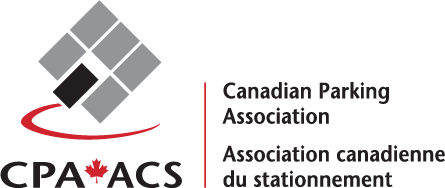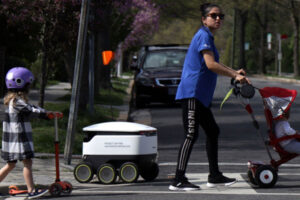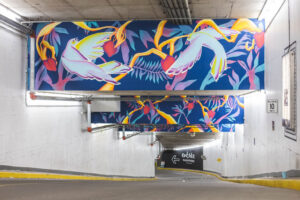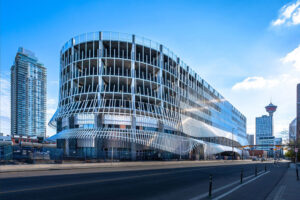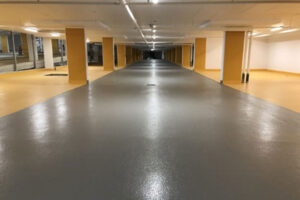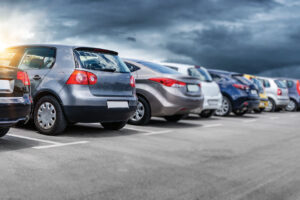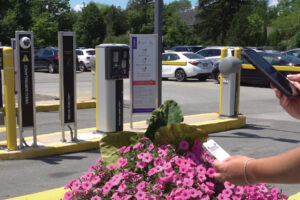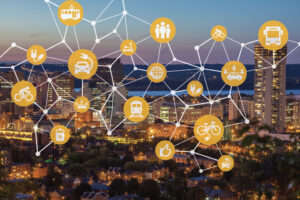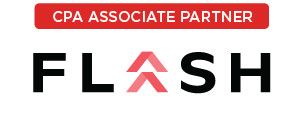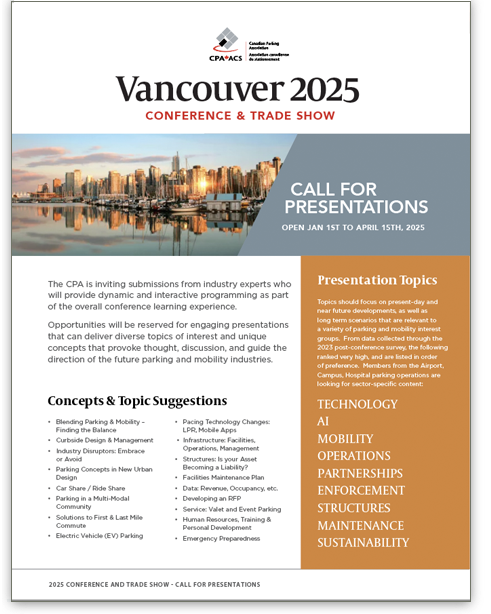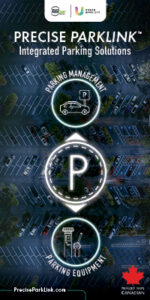By Chris Scheppmann
When we visualize artificial intelligence (AI), we often think of robots learning how to think, so they can perform human tasks. And of course, those of us who are science fiction fans probably envision apocalyptic acts committed by hordes of out-of-control robots. Thankfully, the reality is much safer and more useful than robots learning how to kick a soccer ball. This is particularly true when it comes to parking.
One of the most important recent breakthroughs in parking guidance technology is Machine Learning. Through Machine Learning, parking guidance has become highly accurate and useful, both for helping manage parking inventory and when it comes to providing parking operations with business intelligence to make better informed decisions. But, to understand the role that Machine Learning is playing in parking guidance, it is first necessary to understanding what Machine Learning is.
What is Machine Learning?
Machine Learning is a type of AI. Equipment paired with Machine Learning is able to modify itself when exposed to more data. It is dynamic and does not require human programmers or designers to manually make changes and the Machine Learning models can continually improve its understanding of an environment where it is being used.
As Arthur Samuel, a pioneer of the field stated in 1959, Machine Learning “gives computers the ability to learn without being explicitly programmed.” As an example, Machine Learning is like a child who is born without having any knowledge and adjusts (knowledge improves) its understanding of the world in response to experience (receives new data). As that baby continues to be exposed to similar and new experiences, its ability to make connections and decisions improves. Over time, a child can differentiate between a spotted dog and a cow or a brown-haired dog and a…
By Bern Grush, Harmonize Mobility Inc., Toronto
It is expected that in some places and times service robots will be permitted to operate on public sidewalks, pathways, bicycle paths, and roadways. Will their introduction impact central business districts in our cities? Could they impact parking revenue? Will they create a need for new forms of public, shared-space monetization related to their use?
No one is surprised that we could expect some changes in the parking industry due to AVs, especially autonomous taxis for ridehailing. Ride hailing has already shown it can negatively impact parking demand.1 Surely, if the robotaxi arrives as promised — even cheaper and more reliable than ride-hailing — then parking demand would contract accordingly. But the continuous failure of promises from the autonomous passenger-vehicle industry since 2015 says this scenario is still on the far horizon — if anywhere.
Sidewalk-scaled delivery robots, also called personal delivery devices (PDDs), are far more likely to be in pervasive service in our cities and suburbs sooner than robotaxis will provide regular passenger service. This is because the multiple barriers to deployment of these sidewalk robots are more easily surmounted than the equivalent deployment barriers for the robotaxi.2
The single largest barrier to the robotaxi to date is that they are unable to go anywhere at any meaningful scale without a human in the driver seat. Hence, they cannot immediately threaten the ride-hailing industry. That barrier does not exist for the PDD, which is teleoperated at worst and increasingly merely telemonitored. Today, the leading PDD technology permits one person to concurrently operate two or three. And these can be miles apart.
What that means is that as PDD self-reliance moves from 99% to 99.99%, the ratio of robots to operator will improve from 2:1 and eventually to 10:1…
By Cody Clark
Before I began working in the parking department of my company, I was working in the security field. I completed a course at the Nova Scotia Community College Truro Campus for Law and Security. Within this course I learned a great deal and have applied it to the field of parking operations. One topic I would like to outline today is the Broken Windows theory. Regarding this theory in Law enforcement, the studies that I personally have seen argue that there is not enough data on the subject. There is no concrete or decisive way to attribute this theory to an actual decline in overall crime rates. In this article I will summarize the Broken Windows theory itself and describe how I believe we as employees or owners can apply this theory to the day-to-day functions of parking lots.
The Broken Windows theory in its essence is referenced directly in its name. The theory at its base is that if an area (or in our situation a parking garage/lot) looks derelict or has visible signs that crime has been committed (such as broken windows), it will inadvertently attract additional or more serious crime. To avoid this, pro-active policing of small crimes, i.e., theft, property damage and vandalism, creates an air of lawfulness, and deters such an increase. Knowing what the Broken Windows theory is, at its core, we can now apply this quite easily to our everyday operations. Ensuring all graffiti is removed or painted over and that any damaged or broken equipment is repaired in a timely manner. Doing these tasks quickly and effectively will help paint the picture that your parking garage is monitored and well maintained. A big thing that…
By Alizé Honen-Delmar
What if parking lots walls were used to host art? That’s what the P.ART.KING project is all about, it brings art where we park.
Underground parking lots are usually quite dull and only seen for their utilitarian purpose but P.ART.KING decided to embellish them with murals from local artists to enhance the customers’ experience and democratize arts.
This project emerged in the fall 2020 in Montreal when it won the public prize of the QI_Connexion contest organized by the Quartier de l’Innovation and SDC Montréal centre-ville. Since then, in collaboration with LNDMRK, underground parking lots are transforming into P.ART.KING with stunning murals added onto their walls, all produced from local and emerging artists. Simply put, this project uses the enormous potential of the large white walls of parking lots as its canvas!
Landmark buildings of Montreal such as Place Ville Marie, 1000 de la Gauchetière and Place Montréal Trust got their underground parking lots embellished with unique colorful murals and the feedback has been astonishing! Members of these properties and the users of their parking lots were impressed by this added value that was brought by this project. It felt like a “ray of sunshine in their day”, a customer said.
P.ART.KING collaborates with local artists that create colorful art pieces conveying a positive message of connection, togetherness and hope. The first production of this project, the urban jungle realized by Caitlin McDonagh in the lobby of Place Ville Marie parking, transformed the entire customers experience of this property. Likewise, Place Montréal Trust parking lot benefited from the P.ART.KING project with the addition of 3 impressive murals on the top walls of its ramp entrance. This series created by Julian Palma, has completely changed this parking lot and people started mentioning it as the…
By Reachel Knight, Calgary Parking Authority
In late May, the Platform Innovation Centre & Parkade opened its gates to Calgarians with fanfare, community activities, and more… JUST KIDDING. With Calgary’s third COVID-19 lockdown underway, the Calgary Parking Authority’s (CPA’s) grand opening for its first purpose-built parkade in decades wasn’t quite what we’d envisioned when planning began years ago. Luckily for us, forward-thinking and adaptability are the foundation that Platform Parkade is built on.
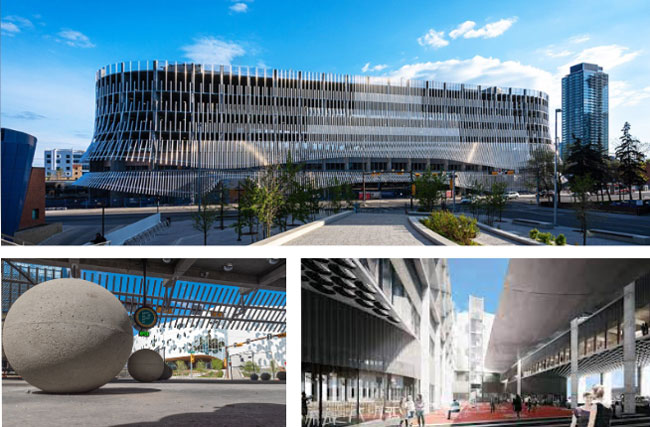
Calgary’s East Village has always been a magnetic neighbourhood, a gathering place that draws visitors to its vibrancy, invention, and beauty (more on that later). Platform Parkade is part of the revitalized East Village urban mosaic. The need for the new parkade location was identified in The City of Calgary’s East Village Area Redevelopment Plan: the creation of Platform Parkade allowed key East Village projects, including the Studio Bell, home of the National Music Centre and Central Library, to be created without standalone parking space. Platform Parkade was designed, developed, and built to address the evolving parking and transportation needs of the neighbourhood.
Throughout the planning process and 2.5 years of complex construction, we worked to create a blueprint for the future conversion of this unique space. Certain design elements will allow the space to be adapted into commercial or residential uses in the future when the needs of the community change.
For example:
- Increased floor-to-ceiling heights to accommodate mechanical, electrical and HVAC requirements for future uses (office and/or residential)
- Slightly sloped floors with no ramp system mean that if/when this building is converted to an alternate use only a minor topper will have to be installed to level out the space. Given that there is no ramp system, no ramps will have…
By Mathieu Verronneau, ing. & Paul Hanratty, MBA
Condominium Parking Garage Maintenance
Introduction
Your parking garage, if not maintained properly, can be one of the most expensive costs to your Condominium Corporation. Repairs to your garage can cost millions of dollars and create massive disruption over multiple years to the quiet enjoyment of your home and investment.
Background
The National Building Code Standard for Parking Structure construction and protection is CSA S413, “The Canadian Parking Standard”. This building code document provides guidance for designers and builders of parking structures. The current issue of this standard is a highly informative document but falls short in several areas related to protection of structural elements within parking structures. Deterioration of structural elements like columns, slabs, ledge beams etc., accelerates quickly if these elements are not protected. De-icing salts greatly accelerate the deterioration of unprotected structures.
One can find all details on this standard at:https://www.csagroup.org/store/product/S413-14/
Historic Building Process
Condominium structures are built by property developers and in most urban settings the parking garage is generally underground. Developers have a two-year obligation to the Condominium Corporation covering non-structural and non-life safety components of the building. This includes waterproofing structural elements in the parking garage and elsewhere. The short warranty period incentivizes some developers to install the minimum protection required by the building code. The current code only requires that elevated slabs be protected by an elastomeric membrane and traffic bearing surface. It does not require that the Architect or Designer of structural protection systems design for durability. This lack of guidance in the building code will be changed significantly with the new iteration of CSA S413:21, due to be released later in 2021. The new code will require that deck membrane systems be designed to receive four distinct levels of…
By Ryan Hickey
For many cities and municipalities, parking is at the center of their decision-making these days, whether it is from a revenue, usage patterns (current and future) or an operations perspective. As we move towards getting back to a new normal in 2021, the issues that were impacting the parking experience prior to COVID-19 are sure to resurface, perhaps with a slightly different appearance.
All too often, there was, and still is, a negative experience related to urban parking, with the majority of community members believing that parking resources are not meeting their needs. This perception is fueled by the length of time it can take citizens to find an available parking stall and is frequently used as the main metric for gauging whether a region has an efficient and sufficient supply of parking. When finding a possible solution, cities and municipalities must consider a large number of variables while planning out parking zones, including budgets, land use, and the overall community experience. Overall, this process becomes extremely overwhelming and can be exacerbated by inaccurate parking data supplied by outdated or inaccurate methods.
Urban planners face a variety of challenges in collecting reliable and accurate parking data to improve overall parking user experiences. Presently, many decision makers are unable to form concrete plans towards improving their parking, due to a lack of real-time data availability, and ever-changing parking behaviours driven by COVID-19. At a time when most individuals are working from home, it could be questioned whether there is a need for increased parking. In some areas of North America, it was noted that parking levels were at an all-time low, as citizens were encouraged to stay home and reduce unnecessary travel. For example, sensor data collected within Stratford, Ontario demonstrated a significant decrease…
By Adamo Donatucci
Like any industry heavily reliant on technology, the urban mobility marketplace continues to evolve with advances in available and emergent technologies. Today, it is common for owners and operators to use technology to engage their customers virtually while retaining an element of personalized interaction.
During the COVID-19 global pandemic, the healthcare industry has proven to be a fascinating case study in the application of advanced parking technology to support the vertical’s broader goals of increasing staff and patient safety while simultaneously reducing hospitals’ and clinics’ capital and operating costs.
Virtualization of the customer experience was driven initially by market preferences for technology-forward service solutions that generated value for parking operators by reducing overall expenses without sacrificing the high level of service that draws traffic to their facility. While this remains an important consideration today, the COVID-19 global pandemic has accelerated efforts to provide the services people need at a distance that keeps them safe.
Early efforts to virtualize the customer experience centered around providing lower-cost alternatives to on-site staffing by directing intercom calls from an attendant’s desk to an off-site monitoring station to save on staffing costs. Today’s technology gives parking operators the flexibility to deploy AI-driven kiosks that assist users to navigate large and complex facilities; in some deployments, this includes turn-by-turn directions back to their car based on the license plate number they enter.
With a greater-than-ever demand for touchless access solutions, parking operators are developing new systems that let users interact with the equipment without ever coming into contact with it; some suppliers have even found ways of integrating gestures to activate ticket dispensing and are leveraging Bluetooth Low Energy technology for permitted access. And just arriving on the market are technology integrations that begin the virtual customer experience before drivers…
By Adam Wenneman
The curbside is one of the most poorly understood parts of the municipal right-of-way. On the one hand, it’s a huge piece of municipal infrastructure that is essential to the urban transportation landscape, supporting billion-dollar industries like goods movement and ride sharing. On the other, it is a scarce – and diminishing – resource whose management principles remain rooted in 20th century technologies.
In a time where curbside uses are growing to include expanded patios, dedicated courier loading zones, and other temporary uses, cities need to leverage innovations in collecting, managing, and sharing curb data to improve the efficiency of operations at the curbside.
The Curbside is a Critical Municipal Asset
The curbside is a major piece of infrastructure for every municipality. Across Canada, on-street parking represents upwards of 20% of a city’s total parking supply1. In some cities, like Saskatoon or St John’s, on-street parking constitutes almost all of the downtown parking supply. In downtown Hamilton alone, there is room for over 1,100 parking spaces at the curbside – that’s an area equivalent to the size of ten NHL-sized ice rinks. Efficient operation of this space is an important factor in a city’s ability to support the future of urban mobility.
Despite its considerable supply, the curbside remains a limited and scarce resource at a time where demand for curb space is at an all-time high. The curbside is a limited resource in that its supply cannot grow substantially in urban areas with well-defined built environments and road networks. At the same time, cities are beginning to repurpose the curbside and even entire roadways for alternative uses like active transportation, outdoor dining, and shared community space2. Make no mistake – increasing the amount of green, livable space in a city can have major…
By Alicia Smart, Passport
Over the past decade, the City of Hamilton has experienced a tremendous influx in urban growth and development. The City, known for its tourism and medical research, is also the fastest growing mid-sized city in Canada for tech and healthcare. This rapid growth and urbanization have caused the City to reimagine its parking operations.
Many areas in Hamilton are undergoing secondary plans to ensure that there are land use, transportation, and infrastructure plans in place to meet the needs of the growing communities. Hamilton’s parking operation handles all on-street parking related matters, inclusive to parking bylaws. In addition to the day-to-day parking that occurs on Hamilton’s 2,700 on-street and 5,000 off-street paid parking spaces, construction, special events and filming heavily utilize parking. Many of the core parking surface lots have made way for urban growth and Hamilton expects this to be a growing trend over the next 10 years.
Up until 2019, a large portion of the City’s parking operation was simply collecting and reconciling cash and coin. Enforcement operations caused a number of issues at the time, including hardware malfunctions and coin jams. Additionally, data collection was almost non-existent due to the coin and cash dependence. “When I joined the parking system in 2017, what I saw was a large group of very hardworking people who were working too hard at the expense of manual processes,” says Amanda McIlveen, City of Hamilton parking operations and initiatives manager. “From past experience, I knew that Hamilton was in need of a massive digital transformation.”
Amanda and her team quickly realized that in a data-heavy industry, it is difficult to run a parking operation efficiently using antiquated and manual processes. Leveraging data allows cities to manage and allocate staff properly, manage parking demand, create efficiency in…

